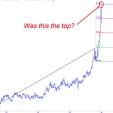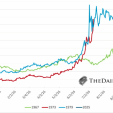Stocks Rise As Zombie Companies Proliferate
Share prices on the major US exchanges are hitting all-time highs at the same time that both the number and percentage of companies that do not make any money at all are rising.
According to the Wall Street Journal, the percentage of publicly-traded companies in the U.S. that have lost money over the past 12 months has jumped close to 40% of all listed corporations--its highest level since the NASDAQ bubble and outside of post-recession periods.
In fact, 74% of Initial Public Offerings in 2019 didn’t make any money as opposed to just 25% in 1990—matching the total of money-losing ventures that IPOED at the height of the 2000 Dotcom mania. The percentage of all listed companies that have lost money for the past three years in a row has surged close to 30%; this compares with just over 10% for the trailing three years in the late 1990s.
The insane behavior of markets can be blamed squarely on central banks and their zeal to perpetuate asset bubbles by forcing interest rates into the sub-basement of history. This, of course, causes savers to leap far out along the risk curve in search of a yield that is far greater than the asinine 2% inflation target from which the Fed has vastly eclipsed long ago.
This market insanity isn’t completely lost on those who occupy the C-suite in corporate America.
According to a recent survey of U.S. corporate CFOs done by Deloitte, 77% of respondents said stocks are overvalued, while just 4% said equities are undervalued. And, a full 97% of respondents say that an economic slowdown already has begun, or will start sometime in 2020.
Perhaps the reason why the Fed has the REPO market in the Intensive Care Unit is precisely because corporate bond prices are nearing the edge of a gigantic chasm. The Federal Reserve Bank of NY is so concerned about the liquidity of money markets that it had to add another $83.1 billion in temporary liquidity to financial markets on Thursday, Jan. 9th alone—adding to the pile of about a half-trillion dollars’ worth of fresh monetary expansion since mid-September of last year.
All this largesse offered by the Fed at record low rates has indeed led to its desired effect. Corporations rushed to sell $69 billion in investment-grade (IG) corporate debt during the first full week of 2020, the second-highest amount ever in a one-week period, according to Bank of America Securities. The rate on the ICE/Bank of America investment-grade corporate bond index has plunged to a paltry 2.87%, as investors chase risk in a desperate search for any kind of yield. The BBB tranche of IG debt, which is just one notch above junk and comprises 50% of all IG debt, is yielding just 3.18%. That record low yield is a full 300 bps lower than it was prior to the Great Recession.
The truth is, there's a record amount of corporate debt, which has the lowest quality of composition and trades at the lowest yields ever. Around the world, there is a half-trillion dollars' worth of negative-yielding corporate bonds that are held by individuals that hope to sell it at a higher price—and fast—because holding a bond to maturity that pays less than the principal guarantees a loss in nominal terms and with a much fatter minus sign attached to it when inflation is factored into the equation.
Nevertheless, corporate bond prices continue to climb along with share prices even though earnings growth has absconded. According to FactSet, the Q4 2019 S&P 500 y/y earnings will be negative 2%. If the Q4 earnings season turns out to be a negative number at all, it marks four straight quarters of y/y negative EPS growth. But, falling earnings doesn’t seem to matter to stock investors much at all when the Fed keeps the confetti machine blowing at full speed--and deteriorating credit quality of corporation doesn’t seem to faze them either.
While the stock market surges to new highs, the credit quality of the U.S. government is faltering as fast as corporate debt. The budget deficit reached $1.02 trillion for the 12-month calendar year ending in December. And, the deficit increased to $357 billion in the first three months of this fiscal year 2020 (Oct., Nov., and Dec.). This deficit is the largest in seven years. It was only higher during the aftermath of the Great Recession. But remember, this is supposed to be the best economy ever. However, it is not; and when the economy starts to contract the annual budget deficits should spike north of $2.5 trillion due to automatic economic stabilizers, just as corporate bond yields become completely unglued.
The continuation of this phony bull market and ersatz economy is predicated on borrowing costs staying at a record low levels forever. This is despite the fact that the level of debt is unsurpassed and growing higher each day. This is the same condition as the real estate bust of 2008: 1.5 trillion dollars’ worth of US Mortgage debt was owed by borrowers who couldn't pay back the loans once home prices stopped rising and interest rates began to rise. Only this time around it is going to be much worse: over $5 trillion worth of corporate debt will most likely become insolvent once the economy stalls and zombie corporations get shut out of the credit markets due to spiking borrowing costs.
In the interim, it is ok to dance on top of these bubbles; but only if you have a robust model that gives enough warning ahead of time to sprint towards the extremely narrow emergency exit. Otherwise, you will buy and hold, and dollar cost average your account to penury. If you doubt, that just ask the Japanese in 1989 how holding on to stocks worked out.
Up until now, the day of reckoning has been held in abeyance by central banks’ willingness to drop borrowing costs to near nothing and by engaging in perpetual QE. But this strategy only works for a while. Now that money has been offered around the globe for virtually free and for a very long time, there isn’t much central banks can do to thwart the next recession outside of dropping money from helicopters (a.k.a. direct debt monetization, or hyperinflation)--but that won’t happen until the next collapse is in full free-fall. Modeling this dynamic will be crucial for investors’ success.

















